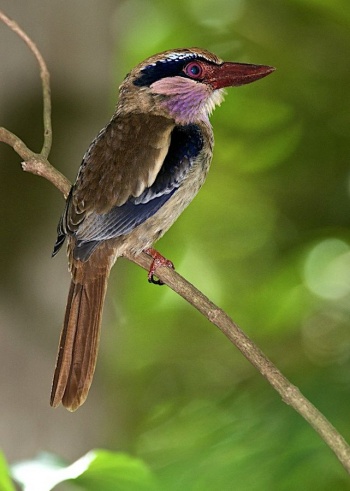
Cittura cyanotis
SUBFAMILY
Halcyoninae
TAXONOMY
Dacelo cyanotis Temminck, 1824, Sulawesi (Sumatra in error).
Three subspecies.
OTHER COMMON NAMES
English: Blue-eared, lilac kingfisher; French: Martin-chasseur
oreillard; German: Blauohrliest; Spanish: Martin Cazador de
Cйlebes.
PHYSICAL CHARACTERISTICS
11 in (28 cm), no mass data. Large kingfisher with unique,
spiky, lilac ear coverts, brown above, lilac and white
below with black (male) or blue (female) shoulder to
dark wings. Black mask, bright red bill and feet. Red iris distinctive.
DISTRIBUTION
Sulawesi in Indonesia, and adjacent larger islands.
HABITAT
Tall primary or secondary rainforest, up to 3,300 ft (1,000 m)
above sea level.
BEHAVIOR
Known to roost on bare branch of low tree. Calls with rapid
descending series of four notes, repeated every few minutes.
Perches for long period in dark forest at middle to lower levels,
watching for prey or for a mate to which it may display
with raised bill and fanned tail.
FEEDING ECOLOGY AND DIET
Swoops down to capture prey on ground, mainly large insects,
such as mantids, cicadas, grasshoppers and beetles, together
with millipedes and small reptiles. Sometimes also hunts along
the edge of clearings.
REPRODUCTIVE BIOLOGY
Nest reported from burrow in sloping ground, no further
data.
CONSERVATION STATUS
Considered Near Threatened due to restricted range, patchy
DISTRIBUTION
and steady removal of its forest habitat. Nowhere
common and biology not well understood.
SIGNIFICANCE TO HUMANS
None known.
Photo Gallery of - Lilac-cheeked kingfisher




 Animalia Life
Animalia Life